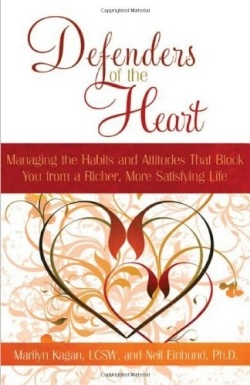Defenders of the Heart
Managing the Habits and Attitudes That Block You From a Richer More Satisfying Life
What works as a protective strategy for children often turns into a block that constricts full satisfaction in adulthood, according to Kagan and Einbund, therapists practicing in Southern California. (Kagan has hosted her own radio and TV shows.) The authors, who have more than forty years of combined experience, observe that habitual defensive responses “hold you back from fully embracing the entirety of your life: emotionally, socially, and intellectually.”
Examining these “defenders of the heart,” and recognizing their patterns is the first step to gaining conscious control. The authors dispense insightful, user-friendly action steps to relieve the blocks. Easy to understand and anecdotal, the ten conversations cover the most common protective strategies left over from childhood traumas: denial, projection, rationalization, intellectualization, humor, displacement, sublimation, procrastination, altruism, and passive-aggression. The authors address the complexity of defenders, acknowledging their beneficial attributes. Seemingly positive defenders like humor and altruism cause suffering when they become “too much of a good thing,” the authors say.
Each chapter defines the defender under discussion, illustrates it with pointed anecdotes, lists the defender’s qualities, and employs acronyms, questions, and exercises that encourage action and healing. The “Heart Beat” section expands the context to include statistics, studies, and reports, while the “Payoff” section outlines the reasons people hang onto their defensive strategies. Their message’s essence is this: “Understanding how burying our true feelings can isolate us from our loved ones and prevent us from leading a gratifying life, and learning how connecting with our emotions opens us up to acceptance and love.”
Ardent procrastinators learn to focus on the “procrastination pile,” with an assignment to work on the same pile for ten minutes—and no more—every weekday at the same time. The discussions of passive aggression and sublimation bring clarity to these over-used and under-defined terms.
With a light touch, real-life scenarios affirm to those searching for that promised “richer, more satisfying life” that they are not alone in facing these challenges. A final section of celebrity stories (including Patrick Dempsey of Grey’s Anatomy and Ryan Seacrest of American Idol) helps readers visualize their own patterns.
Purists may consider this “therapy lite,” but for millions of people actively on the path of personal growth, the authors provide an engaging vehicle for gaining insights into life’s journey. It is an ideal resource for creating conversations within families, among friends, or even in the therapeutic relationship, and opening dialogues enriched by the stories of others.
Reviewed by
Bobbye Middendorf
Disclosure: This article is not an endorsement, but a review. The publisher of this book provided free copies of the book to have their book reviewed by a professional reviewer. No fee was paid by the publisher for this review. Foreword Reviews only recommends books that we love. Foreword Magazine, Inc. is disclosing this in accordance with the Federal Trade Commission’s 16 CFR, Part 255.

